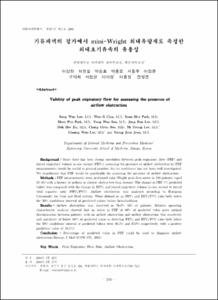KUMEL Repository
1. Journal Papers (연구논문)
1. School of Medicine (의과대학)
Dept. of Preventive Medicine (예방의학)
기류폐색의 평가에서 mini-Wright 최대유량계로 측정한 최대호기유속의 유용성
- Keimyung Author(s)
- Lee, Mi Young; Lee, Choong Won; Choi, Won Il; Jeon, Young June
- Journal Title
- 대한내과학회지
- Issued Date
- 2004
- Volume
- 67
- Issue
- 2
- Abstract
- Background : Since there has been strong correlation between peak expiratory flow (PEF) and
forced expiratory volume in one second (FEV1), assessing the presence of airflow obstruction by PEF
measurements would be useful in general practice, but its usefulness has not been well investigated.
We hypothesize that PEF would be practicable for assessing the presence of airflow obstruction.
Methods : PEF measurements were performed mini-Wright peak flow meter in 106 patients (aged
19-82) with a history of asthma or chronic obstructive lung disease. The change in PEF (% predicted
value) was compared with the change in FEV1 and forced expiratory volume in one second to forced
vital capacity ratio (FEV1/FVC). Airflow obstruction was analyzed according to European
Community for Coal and Steel criteria. When defined as an FEV1 and FEV1/FVC ratio both below
the 90% confidence interval of predicted values before bronchodilator.
Results : Airflow obstruction was observed in 76.4% (81) of patients. Relative operating
characteristic analysis showed that an below in PEF of 60% of predicted value gave optimal
discrimination between patients with no airflow obstruction and airflow obstruction (the sensitivity
and specificity of below 60% of predicted value in detecting FEV1 and FEV1/FVC ratio both below
the 90% confidence interval of predicted values were 86.4% and 83.0% respectively, with a positive
predictive value of 94.5%)
Conclusion : Percentage of predicted value in PEF could be used to diagnose airflow
obstruction.(Korean J Med 67:170-175, 2004)
Key Words : Peak Expiratory Flow Rate, Airflow Obstruction
목적 : 최대호기유속(PEF)은 강제호기량 1초치(FEV1)
에 비해 측정이 간단하며 쉽고 빠르게 검사할 수 있는
장점이 있어 1차 진료기관에서도 쉽게 이용할 수 있다.
PEF와 FEV1은 상관관계가 매우 높으므로, 본 연구에서
는 기류폐색의 진단에 PEF가 유용한지를 조사하고자
하였다.
방법 : 천식 및 만성폐쇄성폐질환으로 진단 받고 치
료 중인 환자들을 대상으로 전향적으로 조사하였다. 기
류폐색은 FEV1과 FEV1/FVC 모두 신뢰구간의 90% 미
만인 경우로 정의 하였고, 대상 환자 106명 중 81명
(76.4%)에서 기류폐색이 있었다. PEF에 따른 기류폐색
의 민감도, 특이도, 양성예측율을 구했다.
결과 : 폐활량측정법으로 기류폐색이 증명된 환자에
서 PEF로 기류폐색을 평가하여 민감도, 특이도, 양성예
측율 등을 구했을 때, PEF 예측치의 60% 미만을 기류폐
색의 진단기준으로 정할 경우 민감도 86.4%, 특이도
83.0%, 양성예측율 94.5%로 나타났다.
결론 : 이상의 결과로 mini-Wright 최대유량계로 측
정한 PEF로 기류폐색을 진단하는 것은 유용한 방법으
로 생각된다.
- Alternative Title
- Validity of peak expiratory flow for assessing the presence of airflow obstruction
- Publisher
- School of Medicine
- Citation
- 이상원 et al. (2004). 기류폐색의 평가에서 mini-Wright 최대유량계로 측정한 최대호기유속의 유용성. 대한내과학회지, 67(2), 170–175.
- Type
- Article
- ISSN
- 1226-329x
- 파일 목록
-
-
Download
 oak-bbb-00690.pdf
기타 데이터 / 325.38 kB / Adobe PDF
oak-bbb-00690.pdf
기타 데이터 / 325.38 kB / Adobe PDF
-
Items in Repository are protected by copyright, with all rights reserved, unless otherwise indicated.